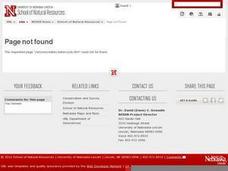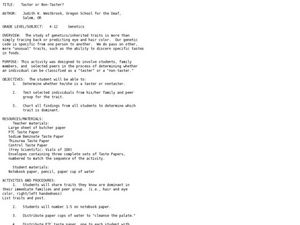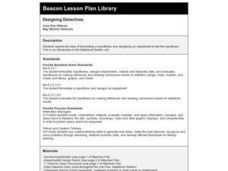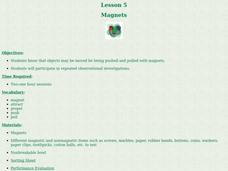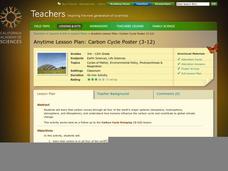Curated OER
It's in the Bag!
Eighth graders measure temperature changes and make drawings of the interactions between matter and energy. By measuring the temperature students can conclude if there are changes in levels of energy.
.
Curated OER
Spelling Strategies for Success
Young scholars identify the meaning of the suffix "er" in given words and sort according to meaning. Students pair up for proofing of work, checking for correct sorting of words in categories of: no suffix, suffix that means "more," and...
Curated OER
South Dakota Quarter Reverse: Four Famous Faces
Learners recognize the faces of the four presidents on the South Dakota quarter reverse. After discussing the duties and responsibilities of presidents, they list the contributions of the four presidents. They decide which presidents are...
Curated OER
Capillary Action and Adhesion
Students perform classroom experiments to observe adhesion. They perform a second experiment using sand, salt, water, and a heat lamp to observe the principle of capillary action. They also experiment with adhesion in plants.
Curated OER
Mountain Barriers
Students examine geographical change. In this mountain barriers lesson, students conduct an experiment to discover how mountains affect surrounding land. Students draw conclusions on how change in land affects plant and animal life.
Curated OER
Function of a Stem
Fourth graders perform an experiment to test the function of a stem. In this science lesson, 4th graders write a description of their investigations. Students also explain how the stem interacts with the rest of the plant. Students use...
Curated OER
Measuring Solar Energy
Students study solar energy and how to measure it. In this energy sources lesson students complete a lab, obtain data and use that to convert surface temperature to energy.
Curated OER
Variable Skies
Students examine factors which affect a vortex and create model tornadoes. They identify variables, pose a testable question, and perform an experiment using the scientific method. After they collect their data, students write a complete...
Curated OER
Taster or Non-Taster?
Learners conduct a simple experiment to determine if a trait has been passed from a family member to them.
Curated OER
What A Gas!
Students study various aspects of air. In this science lesson plan, students discover that air occupies space, understand the visual effects of air, and explain how air exerts force.
Curated OER
Taster of Non-Taster?
Students investigate their own inherited traits by using taste papers. In this genetic traits activity, students test their ability to taste various substances, which is determined by inherited genetic traits. They take home taste papers...
Curated OER
Animal Names
Students match animal pictures with animal words. For this farm animal lesson, students put together the parent and their offspring. Students should have prior knowledge of the basic needs of animals. Students write animal booklets.
Curated OER
Designing Detectives
Third graders explore the idea of formulating a hypothesis and designing an experiment to test the hypothesis.
Curated OER
States of Matter: Solids, Liquids and Gases
Young scholars explore various states of matter. In this science lesson plan, students recognize the properties of each state of matter and recognize the similarities and differences between the three states of matter.
Curated OER
Magnets
Students conduct an experiment. In this magnets activity, students review what they know about magnetism, work in groups to determine the magnetism of various objects and discuss their results.
California Academy of Science
Fish Prints
What do a dead fish, conservation, and paint have in common? The answer is a great lesson plan about fish anatomy, fun print making techniques, and unsustainable fishing practices. The class will start by making fish prints with a...
Curated OER
Sustainable Livestock
Students investigate healthy eating habits by researching livestock. In this food sustainability lesson, students research the negative impact factory farming has on our environment due to pollution. Students define agricultural...
Cornell University
Non-Newtonian Fluids—How Slow Can You Go?
Children enjoy playing with silly putty, but it provides more than just fun. Young scientists make their own silly putty using different recipes. After a bit of fun, they test and graph the viscosity of each.
California Academy of Science
Carbon Cycle Poster
Humans can have a big impact on the environment, specifically the influence they have on the carbon cycle. First, the class will define and discuss each of the earths four major spheres, the biosphere, hydrosphere, atmosphere, and...
Curated OER
Rainforest (Elementary, Social Studies)
Explore the rainforest with your class. Learners study the meaning of the word endangered, choose an animal to study, gather data, and discuss why the animal is in danger of extinction. This is a motivating way to have your class discuss...
National Wildlife Federation
Ghost Town
Around 93 percent of the reefs on Australia's Great Barrier Reef have been bleached, and almost one quarter of them are now dead. Scholars research the sea temperatures, especially around the areas with coral reefs, to make connections...
American Chemical Society
Comparing the Amount of Acid in Different Solutions
Upcoming chemists use chemical reactions to determine relative pH in two different acids. This is a terrific lesson for middle schoolers that can stand alone as a practice in precision and lab skills, or as part of the unit on chemical...
Curated OER
What a Square
Students examine the painting "Old Man With A Gold Chain" by Rembrandt. They identify geometric shapes in the painting, measure these shapes and compare the relationships of these measurements.
Curated OER
Where Did They Come From?
Give science learners nine questions about the biogeography of hydrothermal vents and turn them loose to research this fascinating habitat. Working in cooperative groups, they prepare a report that addresses each of the questions. A...




